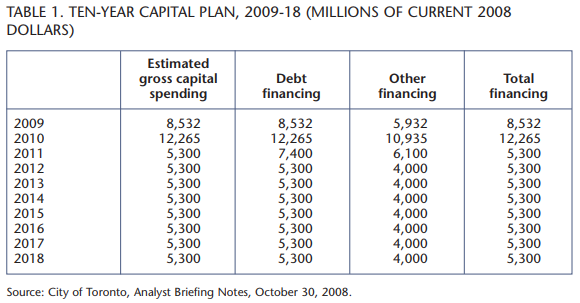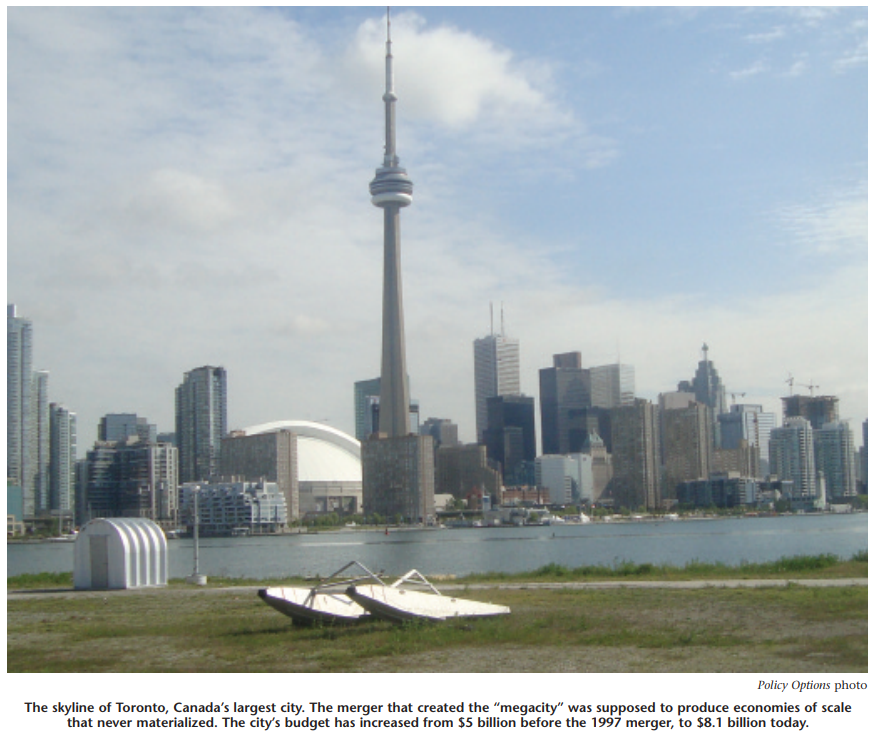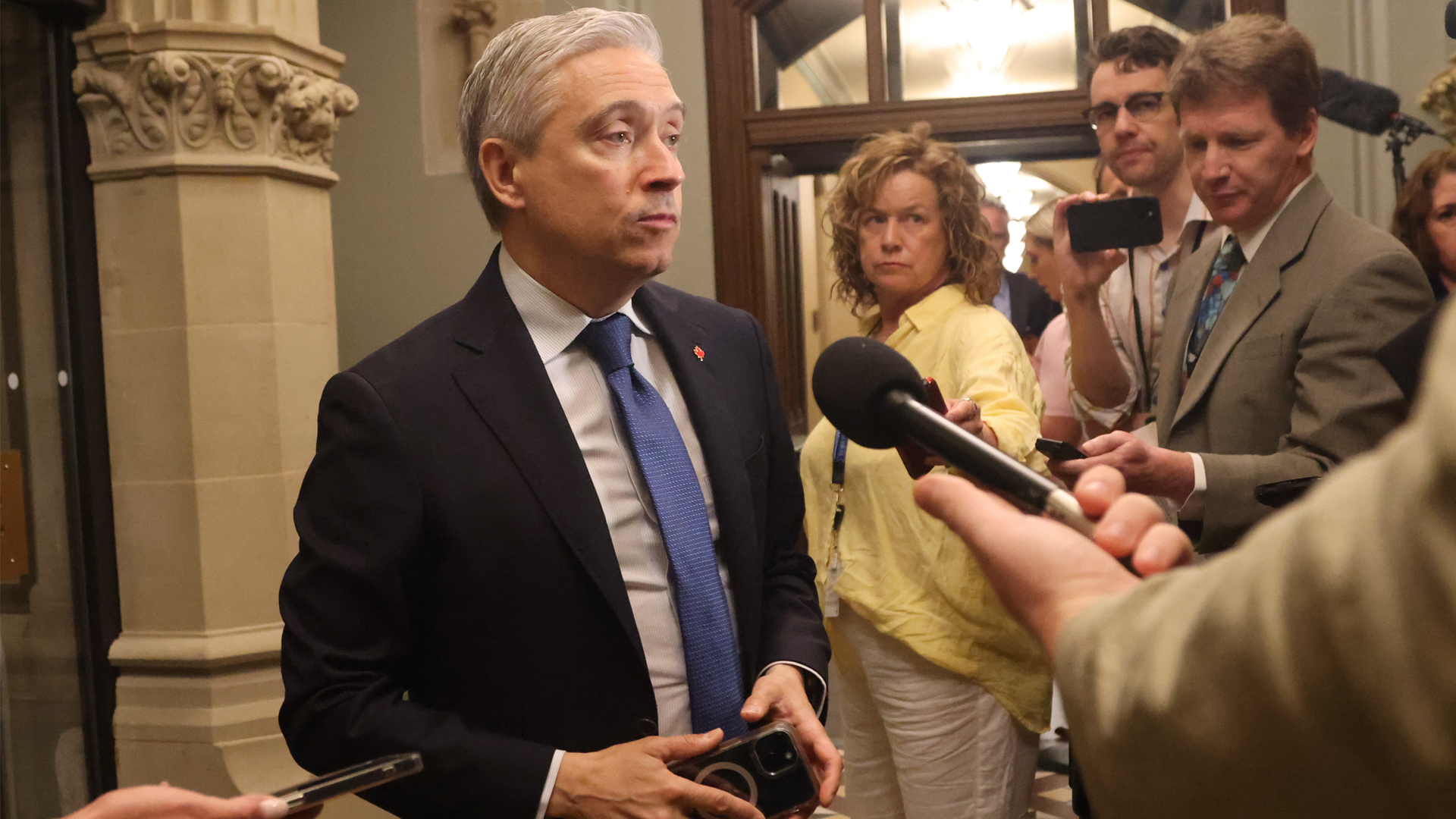
The Municipality of Metropolitan Toronto (Metro) was the first regional government in Canada. It was created in 1954 by the Province of Ontario out of the southern municipalities in York County.
Metro was a two-tiered government. The upper tier provided services for the whole metropolitan area. The lower tier was responsible for local area service, such as local roads, transit and fire protection. The two-tiered government worked well at first. In 1967, following a lengthy Ontario royal commission, the metropolitan government was reorganized. Most of the seven small towns and villages were merged into their neighbouring municipalities. This left the City of Toronto and five townships. All of the townships, except East York, eventually became cities.
When Metro was formed, the members of its council were appointed from among the elected members of the lower-tier councils. In 1967, all the seats were reapportioned according to population. The council was now dominated by the suburban majority. The members of the Metropolitan Council also sat on their lower-tier councils. The Province changed this in 1988 when it required direct elections to the Metro Council. It also cut the links between the two tiers. Now only the mayors of the six municipalities sat on the Metropolitan Council. Metro became too difficult to manage because of the political infighting among the members of the Metro Council and of the six municipalities.
By the 1990s, many people believed that Metropolitan Toronto was no longer relevant since it made up barely 50 percent of the population of the Greater Toronto Area (GTA). The GTA includes the regional municipalities of Toronto, Peel, York, Durham and Halton.
In the 1995 provincial election, the Conservative Party leader, Mike Harris, campaigned on reducing the amount of government in Ontario. After he was elected, he announced that he would replace the two-tiered government of Metropolitan Toronto by a one-tier City of Toronto. In March 1997, a referendum was held in all six municipalities and the proposed amalgamation was rejected by a 3-to-1 majority. Despite the results of the referendum, the government passed a bill creating the new City of Toronto.
The amalgamated city came into being on January 1, 1998. Mike Harris predicted that by reducing duplication the new city would save up to $645 million in the first year and $300 million a year thereafter. The consulting firm of KPMG estimated the transition costs at no more than $220 million. Instead, the new city managed to save only $135 million annually and the transition costs totalled $275 million. The City’s operating budget has increased from $5 billion in 1997 to $8.1 billon in 2008.
The only thing that decreased was the number of municipal politicians. Any cost saving has been offset by increases in the councillors’ staff and in their office budgets. The Ontario government was convinced that it was simplifying local government. Provincial politicians believed that larger cities were better able to reduce costs by eliminating duplication. Therefore, they decided to amalgamate not only Toronto but other cities such as Hamilton and Ottawa.
Amalgamation has made local government more complicated and less transparent, and this has increased costs. Many studies have found that amalgamations do not lower costs; they increase them. Robert Bish provides an extensive list of references to document this point in his C.D. Howe Institute paper “Local Government Amalgamations: Discredited Nineteenth-Century Ideals Alive in the Twenty-first Century.” My colleague Andrew Sancton and I have made the same point in a number of our papers.
Because most municipal costs are related to staffing, most of the savings involve reductions in the workforce. A 2001 City report states that executive management positions were reduced by 60 percent.
Recent data show that in 1998 the city had 45,860 employees. In 2008, the number of employees was 50,601. Therefore, since 1998, the City’s employment has increased by 4,741, or about 10 percent. In 2009, the City planned to add another 1,300 workers to its payroll. The total increase over 1998 is now 6,041.
Downloading involved the Province transferring responsibility for many of its social welfare programs to the cities. These included the cost of welfare, public housing, and health and safety, among others. The purpose of downloading was to reduce the size of the Ontario budget and allow the Province to reduce taxes. The harmonization of wages and salaries (discussed below) further increased the City’s wage bill.
In the 1995 provincial election, the Conservative Party leader, Mike Harris, campaigned on reducing the amount of government in Ontario. After he was elected, he announced that he would replace the two-tiered government of Metropolitan Toronto by a one-tier City of Toronto. In March 1997, a referendum was held in all six municipalities and the proposed amalgamation was rejected by a 3-to-1 majority. Despite the results of the referendum, the government passed a bill creating the new City of Toronto.
Annual amalgamation costs involve the harmonization of services, the harmonization of wages and salaries and the annual debt-service costs.
The new city wanted to equalize the services and fees for waste and recycling collection, winter maintenance, public health, parks and recreation, and boulevard parking fees. These services were identified as having the most significant differences between municipalities when amalgamation took place. The financial constraints faced by the new city prevented these services from being harmonized at the highest level, as is normally the case. Instead, service levels in some parts of the new city rose and in other parts fell. Fees were harmonized in the same way.
Prior to amalgamation, Metro and each of the six local municipalities paid their employees different wages and salaries for the same job. The City first harmonized the wages and salaries of management and its non-union workforce at a one-time cost of $2 million. The unionized employees’ wages and salaries were settled by negotiations, mediation or arbitration after the workers went out on strike. The task of integrating and harmonizing the collective agreements was especially difficult. It involved the consolidation of 55 labour contracts into 15.
Toronto’s ability to raise revenue is constrained by the Ontario Municipal Act and the reluctance of the provincial and federal governments to provide additional aid. Provincial and federal government transfers to municipalities have increased since this paper was prepared.
The new City of Toronto Act came into force on January 1, 2008. The new Act gives the City more power to raise revenue. Two new taxes were introduced: on the transfer of land and on the renewal of automobile licences. The City also planned to increase the tax on garbage collection by 2 percent. However, City Council voted to use the $4.8 million that the City saved when its workers went on strike in 2009 to offset the planned 2 percent increase for 2010. The planned 9 percent increase in water rates was not affected and it will go ahead as planned. The water utility plans to use the money to implement a capital works program that will replace aging water and sewer infrastructure.
Ontario is concerned about its deteriorating infrastructure. Capital expenditures involve the construction or acquisition of new buildings, roads, sewage facilities, transit vehicles and other assets that provide the services required by residents. Capital expenditures also involve the maintenance and repair of existing capital assets. Before 2004, a large share of the revenue to finance Toronto’s capital assets came from borrowing from the Province and the capital market. After 2004, the City received increased funding from provincial government transfers. This allowed for a significant increase in the capital budget as the City tried to meet its infrastructure needs.
The 2008 federal government budget set up the Building Canada Fund to help stimulate the economy. The fund provides grants to finance provincial highways, public transit, rural infrastructure and other infrastructure under a new federal-provincial government agreement. The amount allocated to Ontario is $6.1 billion. Additional funding of $2.98 billion will come from a gas tax refund program. Ontario will provide additional funding to the municipalities of $3.1 billion.
In June 2009, Canada and Ontario published a list of projects that the two governments had agreed to fund. The two governments will fund two thirds of the eligible costs of the projects, and the municipalities will fund the other one-third. The program faces significant lags since it takes time for the municipalities to decide on what they want to do and it takes an even longer time for the federal and provincial governments to approve the projects. At this stage, the Canada-Ontario Building Canada Fund is a long way from spending the $9.3 billion that was allocated to the program.
The city’s operating cost budget increased by $744.2 million when Toronto was amalgamated, jumping by 18 percent from 1997 to 1998. After 1998 the changes were small, but in most years there was an increase in the budget.
After the current mayor, David Miller, took office in 2004, the net debt increased by $1.2 billion. The city has serious financial problems that are not being addressed by the current administration. The increase in the size of the operating budget despite attempts to reduce costs indicates that amalgamation has not reduced costs; it has increased them. The tax revenue collected is not sufficient to pay for operating costs. As a result, the City has had to raid its reserve funds and there is very little left in these accounts.
Five months after City Council passed an $8.2-billion operating budget for 2010, it appeared that soaring welfare costs would further jeopardize the City’s financial position. The number of welfare cases is expected to top 100,000 in 2010. This will produce an estimated $8.7-billion operating budget for 2010.
The $8.7-billion budget means that Toronto will have an operating cost budget deficit of $500 million. The City Manager circulated a memo on October 9, 2009, asking all departments to cut 5 percent from their operating budgets over the next two years. The cost reductions will come about by a freeze on new programs, and by cutting discretionary spending on travel for conferences. Toronto’s agencies, boards and commissions are also required to cut their projected 2010 spending.
The operating cost reductions will not be sufficient to prevent a deficit in the City’s operating budget. The savings would be $340 million this year and $170 million next year. Since municipalities are not allowed to run operating cost deficits, the rest of the deficit would have to be covered by further cuts, increased property taxes, user fees, a reduction in the City’s reserves and transfers from the federal and provincial government.
Table 1 shows the current dollar estimates of the City’s debt from 2010 to 2019 based on the proposed capital budget. The table shows that the debt is expected to rise in 2011 and 2012 and then fall in 2013. In 2013 there is a very large increase in debt as transfers from the federal and provincial government fall. Over the period 2010 to 2019 the debt is expected to reach $4.69 billion. The increased debt will create a significant burden for the City because the interest on the debt is paid from the operating cost budget.
The City’s 10-year capital budget calls for an increase in debt to accelerate infrastructure projects, in order to qualify for funds provided by the federal and provincial governments and to take advantage of the historic low interest rates.
The capital budget calls for $25.7 billion in investments over the next 10 years. More than 70 percent of the new budget is for public transportation. This includes $11 billion for the purchase of 60 subway cars, 204 streetcars and 390 buses. Almost $10 billion will be spent on roads and bridges. Over 500 projects that will take place this year. Some projects were brought forward to take advantage of the Canada Builds grants.
A city report estimates the cost of repairing the city’s aging water and sewage system at $4.4 billion. The data in the table also show that the capital expenditures will be financed by grants from the federal and provincial governments and by borrowing. The City proposes to sell $600 million of 30-year debentures.
The Toronto Transit Commission (TTC) was asked to cut its capital cost budget by $848 million. The requested cuts provide more evidence of the City’s financial crisis as it tries to deal with $2.5 billion in debt and to preserve its credit rating. The TTC will revise its capital budget with $548 million in new cuts. The city decided to absorb the remaining $300 million.
The city forced the TTC to shelve the $548 million in planned projects that were scheduled over the next 5 to 10 years. The TTC will also face significant budget pressure in the coming months since it has been asked to find an additional 5 percent worth of cuts in its operating budget for next year. The savings will come from deferring or halting more than 40 projects.
These include the modernization of some of its subway stations, the purchase of 50 clean-diesel buses and other capital projects.
If the cuts are implemented, riders would find 270 fewer buses, 20 to 30 bus routes cut and no new buses until late 2010. The plan to cut bus service waiting times to a minimum of 20 minutes would be abandoned, and the downward spiral for the entire transit system would begin.
The TTC also decided to increase its fares. This is the first significant across-the-board increase since the early 1990s. It will generate an additional $62 million in revenue to offset raising labour and fuel costs.
Toronto’s new 10-year capital plan calls for an increase in its debt to accelerate infrastructure projects. The City is concerned about its debt target guidelines, which prohibit it from spending more than 15 percent, or about $460 million, of property tax revenue on interest and debt repayments. The original TTC budget would have put Toronto well above the threshold for credit rating agencies. A downgrading in Toronto’s rating would cost it tens of millions of dollars in higher interest charges over several years.
In order to keep debt-servicing charges at 15 percent of the property tax and to maintain its AA+ credit rating, the City proposed a new financing strategy. It will use $600 million from Toronto Hydro to pay down existing debt. It will also take out a 30-year debenture to fund the expansion projects.
On February 23, 2009, the City published a staff report on the size of Toronto’s reserves and its reserve fund balances. The report states that the vast majority of these reserves have already been committed to future capital projects. The reserve fund balances at December 31, 2009, will be $2.8 billion, compared with $2.2 billion one year earlier. The planned use of these funds for capital projects represents future liabilities. As a result, there are only minimal amounts left for discretionary spending. The City continues to draw on the reserves and the reserve funds in 2010 to finance both capital and operating expenditures.
One important characteristic of a good or service provided by government is related to spillovers or externalities. Spillovers are the benefits or costs that a government incurs when people outside its territory consume its goods or services. If there are no spillovers, then the municipality should be responsible for funding the good or service.
If spillovers are present and they affect adjacent municipalities, then the good or service should be funded by a regional government or regional authority. If the spillovers occur only within the province, the good or service should be funded by the provincial government. If the spillovers are national, then the federal government should be responsible for providing the good or service. Unfortunately, this has not happened. Toronto is paying for many goods and services that affect people outside of its borders. The City should not have to pay for goods and services that fall within the areas of responsibility of the Province or the federal government. Programs that involve income redistribution are not the responsibility of local governments.
The City’s role is to provide the services mandated by the Province. Financing is determined by who receives the benefits. The benefits principle is based on the proposition that those who receive the benefits from consuming a good or service should pay for the costs of producing it. The major difficulties associated with the benefits principle are finding out who benefits from a particular good or service and setting the correct price or tax.
For some services, such as water and sewer services, identifying who benefits is simple. For other goods and services, such as the construction and maintenance of local roads, identifying who benefits is more difficult. Setting a price that the user is willing to pay for a service is one possible approach. If this is approximated in the production and sale of any local good or service, society’s resources will be put to their best use.
Municipalities have a number of revenue-generating instruments such as user fees, property taxes and grants from higher levels of government. Municipalities provide a wide range of goods and services. Some of these goods and services show private-good characteristics, whereas others show public-good characteristics.
In funding private goods, user fees are more likely to achieve the three goals of efficiency, accountability and fairness. The City can also use the property tax to pay for public goods with no externalities. If externalities are present, senior levels of government could provide grants to help local governments pay for these goods and services. There is no clear way of determining which local tax should be used to finance the production of goods and services that have public-good characteristics.
Grants can be conditional or unconditional. Conditional grants are useful when externalities are present. Unconditional grants are useful to bridge the gap between municipal expenditures and revenue. Grants can also be used for income redistribution and service equalization programs. Federal grants are small compared to provincial grants. Federal grants are also useful when municipal spending is related to federal government activity such as immigration policy.
One important result of Toronto’s amalgamation is a serious mismatching between the City’s revenues and its costs. The shortfall is partially due to the downloading of provincial government responsibilities onto the cities. The Toronto Board of Trade set up a task force to look at the implications of amalgamation. It recommended that the City fully optimize its operating efficiency and its existing revenue sources. The task force did not want to see taxes rise. It believes that the Toronto business community already carries an inequitable tax burden.
The Board of Trade recommended that the Province upload Toronto’s social programs and transit costs. This would realign the City’s expenditures and revenue responsibilities. Alternatively, the Province should provide the City of Toronto with access to sales taxes as well as a hotel room tax. The board also recommended that the Province reduce its sales tax by 1 percent and allow the City the right to levy a sales tax between 0 and 1 percent. The Province would collect the tax and remit it to the City. Under this plan the City would be able to access a wider variety of revenue sources should it require additional revenue in the future for city-building.
The report concludes that the City of Toronto should also prepare the groundwork for an extensive system of local taxes such as gasoline, tobacco, liquor and parking taxes as well as user fees. Most of these taxes can be piggy-backed onto the provincial taxes. The Province would collect the taxes and remit them to the City. Under this plan the City would be able to access a wide variety of revenue sources such as excise taxes and user fees if it requires additional revenue for city-building. The new revenue sources should take policy considerations into account such as equity, economic impacts and visibility, among others.
Mergers that are imposed on communities despite the opposition of their residents are in conflict with basic democratic principles. The mergers are based on the view that the senior levels of government and its civil servants know what is best for the residents of the amalgamated communities.
Mergers that are imposed on communities despite the opposition of their residents are in conflict with basic democratic principles. The mergers are based on the view that the senior levels of government and its civil servants know what is best for the residents of the amalgamated communities.
The Canadian Federation of Municipalities has approved a resolution to “support the rights of citizens to decide the form and structure of their own municipal government.” Bish expresses similar views when he states: “The 21st century will require institutional adaptability to rapid change.” Yet in the critical area of the relationship among citizens, the civil community and local governance, “some provincial governments are imposing an intellectual fashion of the nineteenth century on monolithic government organization and central control.”
One of the justifications given by the provincial government to support amalgamation was that it would reduce costs by eliminating duplication and simplifying municipal government. The evidence from the new City of Toronto indicates that amalgamation did not reduce costs; it increased costs. Whether the City will be able to cut costs in the future without reducing service levels is not entirely clear. Initial indications subsequent to amalgamation indicate that it has not. Most studies on amalgamation show that a reduction in costs is not likely.
In pre-amalgation reports on governance in the GTA, the major concern was the coordination of service delivery across the region. The creation of the new amalgamated City of Toronto did not address the main problem of governance across region. The provincial government agency charged with the responsibility of coordinating transportation services across the GTA is Metrolinx. It is the only agency with a regional mandate.
Amalgamation and downloading have produced an untenable financial problem for the new city. It is not financially self-sufficient. Toronto is faced with operating and capital costs that have been downloaded by the Province. This has placed a significant burden on the property tax. The Province previously restricted the City to the property tax and user fees for additional revenue. Under the new City of Toronto Act, other revenue sources are now open to the City, such as a tax on land transfers. Other solutions have been suggested such as selling off some of the City’s real estate.
One possible solution is to set up a regional government for the GTA. This government would be responsible for the provision of services and for planning for the whole region. In the City of Toronto, a partial de-amalgamation is also possible based on the four existing community councils, Toronto North, South, East and West. Moving away from a highly centralized city might solve some of the problems faced by the City of Toronto. However, this would create other problems. The major problem is how to de-amalgamate city services that have been amalgamated for over 10 years.









